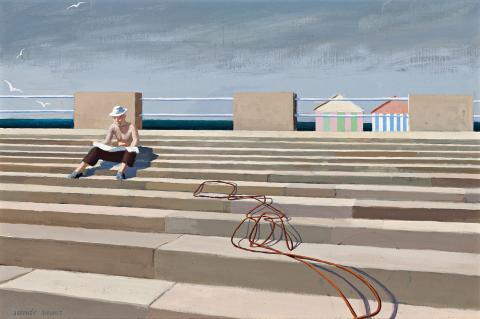FIRST STUDY FOR OSTIA, 1969 – 70
JEFFREY SMART
oil on canvas on composition board
31.0 x 46.0 cm
signed lower left: JEFFREY SMART
South Yarra Galleries, Melbourne
Private collection, Perth, acquired from the above in 1970
Recent Paintings by Jeffrey Smart, Leicester Galleries, London, 5 – 27 June 1970, cat. 16
Jeffrey Smart, South Yarra Galleries, Melbourne, 17-30 November, 1970, cat. 20
Quartermaine, P., Jeffrey Smart, Gryphon Books, Melbourne, 1983, cat 545, p. 111.
McDonald, J., Jeffrey Smart: Paintings of the ’70s and ’80s, Craftsman House, Sydney, 1990, p. 156, no. 21
Smart, J., Capon, E., Greer, G., Jeffrey Smart: Drawings and Studies 1942 – 2001, Australian Galleries in association with Jeffrey Smart and Australian Art Publishing, Melbourne, 2001, p. 85, cat. 98 and 99
Ostia, 1969 – 70, oil on canvas, 66.0 x 100.0 cm, Deutscher and Hackett, Melbourne, 26 November 2014, lot 14
Figure Study I 1969 for Ostia, 1969 – 70, pencil on paper, 22.5 x 17.0 cm
Figure Study II 1969 for Ostia, 1969 – 70, pencil on paper, 16.5 x 23.0 cm
Painting for Jeffrey Smart is always about the fundamentals of art and the achievement of excellence in composition and colour, paradoxically wrapped in the inexplicable. His carefully crafted studies, such as First Study for Ostia, 1969 – 70 provide fascinating insights into such achievement. Absorbing in its own right, a comparison with the ‘finished’ Ostia 1969 – 70 shows that the motifs in both are much the same. Arrangement is where we see the master at work. In general, the composition for the bigger painting has been reversed and is much tighter. Buildings are transformed into a single block, and the railing has gone. Nevertheless, it can be argued that they are really two different paintings. Using playing cards as an analogy, the pack has been shuffled differently.
Smart’s move to Italy in 1965 introduced a range of unique subjects, particularly the new with the old, as in Ostia. Ostia Antica was the port city of ancient Rome, then at the mouth of the river Tiber. The nearby Ostia, founded in 1884, became a sea resort favoured by the Romans. Earlier, at E.U.R. (Esposizione Universale Roma), the very modern business and residential area in Rome, Smart had introduced the subject of a person, seated atop a long flight of stairs, reading. E.U.R. I, 1964 in the collection of the Newcastle Art Gallery, New South Wales, is a striking example. These Ostia and E.U.R. paintings share the same powerful visual rhetoric of steps ascending, smooth or textured of stone, revealing Smart’s love of geometric form echoed in buildings, lamps and railings – immediately contradicted by the snaking cable to tease the imagination. In each, the anonymity of the single figure provides an acute sense of isolation. 1
The culmination of Smart’s first years in Europe was seen in his solo shows at London’s Redfern Gallery in 1967 and at Leicester Gallery in 1970. The three versions of Ostia were included in the latter together with several of his now highly acclaimed works – End of the Autostrada, 1968 – 69 (private collection), Control Tower, 1969 (Art Gallery of South Australia, Adelaide), and Castelfusano, 1970 (private collection). Another, Outside the Ministry, 1970 (private collection) shows Smart’s continuing interest in giving dominance to flights of steps. A further major work from this time of celebrated achievement is the commissioned mural City Landscape, 1969 – 70, Smart’s largest work and now in the collection of the Art Gallery of New South Wales, Sydney. As often in his smaller works, as First Study for Ostia reveals, Smart evokes a more natural feel for his atmosphere, extended by the sea gulls wheeling through a lighter air, shadows softer, more like in life. The atmosphere for Ostia is surreal. Drama fills the air with anticipation as suspense replaces relaxation in the balmy breeze of a sunny day.
1. Smart made two pencil studies of this figure, carefully recording the fall of light from left and right. See Smart, J., Capon, E., Greer, G., op. cit., cat. 98, Figure Study I 1969 for Ostia, 1969 – 70, and cat. 99, Figure Study II 1969 for Ostia, 1969 – 70. For the first pencil study Smart wrote, ‘There must have been some problems with deciding from which direction the light was to come. Here it is from the left’.
DAVID THOMAS
